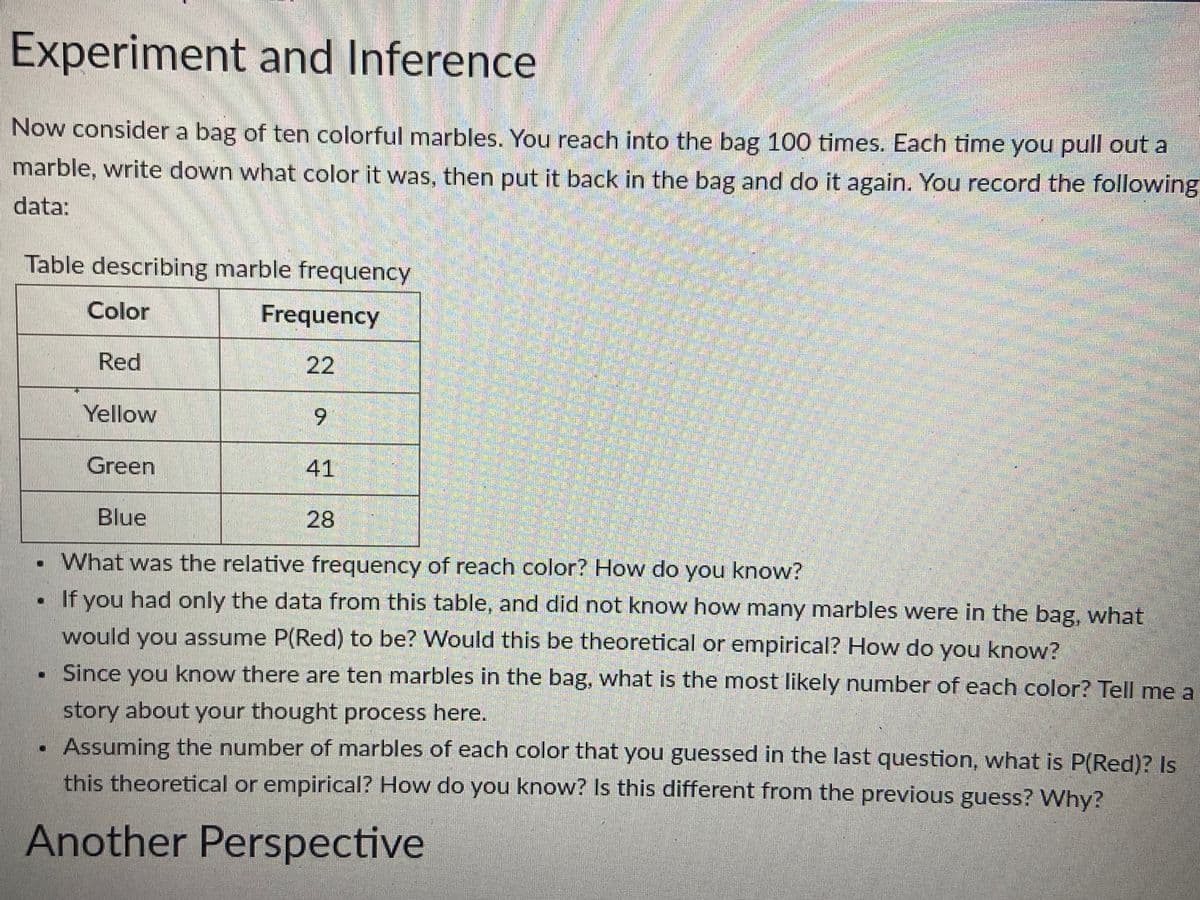Now consider a bag of ten colorful marbles. You reach into the bag 100 times. Each time you pull out a marble, write down what color it was, then put it back in the bag and do it again. You record the following data: Table describing marble frequency Color Frequency 22 ● Red Yellow Green . Blue 9 • What was the relative frequency of reach color? How do you know? If you had only the data from this table, and did not know how many marbles were in the bag, what would you assume P(Red) to be? Would this be theoretical or empirical? How do you know? . Since you know there are ten marbles in the bag, what is the most likely number of each color? Tell me a story about your thought process here. Assuming the number of marbles of each color that you guessed in the last question, what is P(Red)? Is this theoretical or empirical? How do you know? Is this different from the previous guess? Why? Another Perspective 41 28
Now consider a bag of ten colorful marbles. You reach into the bag 100 times. Each time you pull out a marble, write down what color it was, then put it back in the bag and do it again. You record the following data: Table describing marble frequency Color Frequency 22 ● Red Yellow Green . Blue 9 • What was the relative frequency of reach color? How do you know? If you had only the data from this table, and did not know how many marbles were in the bag, what would you assume P(Red) to be? Would this be theoretical or empirical? How do you know? . Since you know there are ten marbles in the bag, what is the most likely number of each color? Tell me a story about your thought process here. Assuming the number of marbles of each color that you guessed in the last question, what is P(Red)? Is this theoretical or empirical? How do you know? Is this different from the previous guess? Why? Another Perspective 41 28
Glencoe Algebra 1, Student Edition, 9780079039897, 0079039898, 2018
18th Edition
ISBN:9780079039897
Author:Carter
Publisher:Carter
Chapter10: Statistics
Section: Chapter Questions
Problem 27SGR
Related questions
Question
I'm looking for help on the first 3 bullet points please.

Transcribed Image Text:Experiment and Inference
Now consider a bag of ten colorful marbles. You reach into the bag 100 times. Each time you pull out a
marble, write down what color it was, then put it back in the bag and do it again. You record the following
data:
Table describing marble frequency
Color
Frequency
Red
22
Yellow
Green
Blue
9
41
28
What was the relative frequency of reach color? How do you know?
If you had only the data from this table, and did not know how many marbles were in the bag, what
would you assume P(Red) to be? Would this be theoretical or empirical? How do you know?
. Since you know there are ten marbles in the bag, what is the most likely number of each color? Tell me a
story about your thought process here.
Assuming the number of marbles of each color that you guessed in the last question, what is P(Red)? Is
this theoretical or empirical? How do you know? Is this different from the previous guess? Why?
Another Perspective
Expert Solution
This question has been solved!
Explore an expertly crafted, step-by-step solution for a thorough understanding of key concepts.
Step by step
Solved in 2 steps

Recommended textbooks for you

Glencoe Algebra 1, Student Edition, 9780079039897…
Algebra
ISBN:
9780079039897
Author:
Carter
Publisher:
McGraw Hill

Holt Mcdougal Larson Pre-algebra: Student Edition…
Algebra
ISBN:
9780547587776
Author:
HOLT MCDOUGAL
Publisher:
HOLT MCDOUGAL

Glencoe Algebra 1, Student Edition, 9780079039897…
Algebra
ISBN:
9780079039897
Author:
Carter
Publisher:
McGraw Hill

Holt Mcdougal Larson Pre-algebra: Student Edition…
Algebra
ISBN:
9780547587776
Author:
HOLT MCDOUGAL
Publisher:
HOLT MCDOUGAL